
Email: vern@cres.org — mailing address: Box 45414, Kansas City, MO 64171-8414
CRES is a 501(c)(3) organization promoting understanding of all faiths through teaching, writing, and consulting.

CRES is a 501(c)(3) organization promoting understanding of all faiths through teaching, writing, and consulting.
| INDEX
About
CRES participation
2017 REPORTS Candlemas — 2017 Feb 2 Thurs 7 pm World Religions Lectures — 2017 Feb 17-18 Fri-Sat When
Even Evil Will Ordain the Good — 2017 Mar 8, 15, 22, 29
12th Annual Dialogue and Friendship Dinner — 2017 Apr 6 [ 50th
Anniversary of Church founding ] — 2017 Apr 6
[ Table of Faiths ] - Interfaith Council Annual Dinner — 2017 May 9 [ CRES Intern Geneva Blackmer ] receives degree — May 10 Sacred — the movie — May 18 Thurs 7 pm [ A 75th Birthday ] a personal entry May 25 Interfaith Pride Service — 2017 May 31 Weds 7 pm Chances Are Vital Conversations 2017 July 12 Weds 1-2:30 pm Islam and ToleranceVital Conversations 2017 Oct 11 Weds 1-2:30 pm Healing Religious Bias — 2017 Oct 25 Wednesday 9-11 am Has Science Eclipsed Religion? — 2017 Oct 28 Saturday brunch Interfaith Thanksgiving Dinner — 2017 Nov 12 Sunday 4-6:30 Vital Conversations — The Full Year
OTHER ANNOUNCEMENTS
#Candlemas CANDLEMAS: IN LIGHT, MUSIC, POETRY 2017 — for 2018 click here Grace and Holy Trinity Cathedral, 13th at Broadway, Kansas City, MO Our Feb 2 Thu 7pm was a highlight of the season.
The original announcement included this information: The Mass for Four Voices by William Byrd
This observance of a traditional Christian feast day is honored with references to many faiths around the world, from the Paleolithic to the present, in the sonnets selected for the occasion, embraced by music from Elizabethan times when the English sonnet was defined by Shakespeare, the Quadricentennial of whose death we also mark. SoulJourners
Lectures
Vern lectures in Atchison on world religions for students in the Benedictine Sister's Souljourners spiritual formation program leading to spiritual direction ministry at the Sophia Center, 751 South 8th Street, Atchison, Kansas 66002 Vern described the three families of faith by telling stories suggesting where they typically find the sacred; epitomizing texts were studied; Buddhism and Islam were given special attention; and the benefits of interfaith exchange were celebrated.
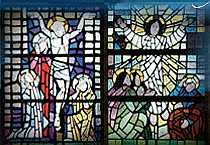
A LENTEN SERIES
When Even Evil Will Ordain the Good Using themes from world religions to illumine the
Christian tradition, the Reverend Vern Barnet, DMn, explores the powerful
mysteries of the crucified and resurrected love of our Savior through the
texts of sonnets from the "Credo" section his new book, Thanks
for Noticing: The Interpretation of Desire.
Mar 8 - The Jesus of History or the Christ of Faith?Readings: Sonnet 82; Mar 8 -79; Mar 15 - 80 (? 85); Mar 22 - 84; Mar 29 - 86 (? 88). Art to illustrate the themes Two views of an icon of Christ teaching (Mar 8) and Velazquez’s "Christ after the Flagellation contemplated by the Christian Soul" (Mar 15)
The Dialogue Institute Kansas City, UMKC Division of Diversity and Inclusion, and UMKC's International Dialogue Student Ass'n cordially invite you to the 12th Annual Dialogue and Friendship Dinner Members of different cultures join to enjoy cultural diversity Global Warming of Hearts: Love and Acceptance 2017 April 6 Thursday 6-9 pm
Host Committee: Peggy Dunn, Mayor of Leawood; Carl Gerlach, Mayor of Overland Park; Ron Slepitza, President of Avila University; Marvin Szneler, Executive Director of JCRB - AJC; Jeremiah Morgan, Stake President- the Church of Jesus-Christ of LDS; William B. Rose-Heim, M.Div, Regional Minister and President Christian Church of Greater Kansas City; Sheriff, Calvin H. Hayden, Sheriff, Johnson County The evening featured Eve Levin, PhD, as Keynote Speaker, chair, History Department, University of Kansas. Donna Ziegenhorn presided over the evening with music by Cindy Novelo, remarks by Ron Slepitza, and awards given to Dr Jospeph Sopich, the Down Syndrome Guild, and Cornerstones of Care. Music was provided by Cindy Novelo The Invocation by Vern, wearing a stole with symbols of many world religions, appears below. on the theme "Global Warming of Hearts: Love and Aceptance"
SPIRIT OF UNDERSTANDING,
SPIRIT OF UNDERSTANDING,
SPIRIT OF UNDERSTANDING,
SPIRIT OF UNDERSTANDING,
Save us, O SPIRIT OF UNDERSTANDING,
May you, O SPIRIT OF UNDERSTANDING,
--The Reverend Vern
Barnet, DMn
#170507 Shawnee Mission Unitarian Universalist Church Observes 50 years
Vern was the congregation's second minister, 1975-1984. He appears in the middle of the top row of the church's archive wall of photographs of former ministers, with the incumbent, Rose Schwab, shown in the final picture, who graciously recognized her predecessor during the celebration 2017 May 7. It was in the seventh year of Vern's ministry that the congregation encouraged Vern to begin CRES.
#170509TableOfFaiths TABLE OF FAITHS 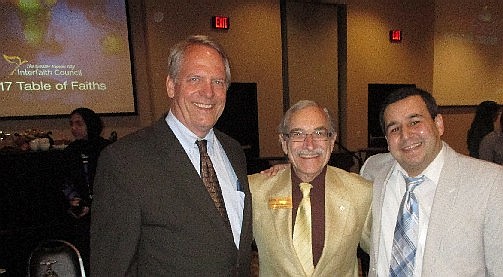
Sophia Kahn, MD, was this year's recipient of the Steve Jeffers Leadership Award, shown here in the middle with some of many friends and admirers. She was recognized for her efforts in many fields, but on this occasion particularly for or inspiring leadership in "KC for Refugees." Previous recipients include Queen Mother Maxine McFarlane (2010), Donna Ziegenhorn (2011), Mayor Sly James (2012), Bambi Shen (2014), the Rev Dr Wallace Hartsfield Sr (2015) and Shakil Haider (2016). For the Cultural Crossroads report of the event, click here.
170518Sacred Sacred - The Movie May 18 Thurs 7 pm Tivoli Theatre Al Brooks, Donna Ziegenhorn, Sunyananda Dharma discuss the movie afterwards with Vern Barnet
Sacred immerses the viewer in an exploration of spirituality across cultures and religions. At a time when religious hatreds dominate the world’s headlines, this film, sweeping in global reach and yet intensely intimate, explores faith as primary human experience: how it is used to navigate the milestones and crises of private life. Directed by Academy Award® winner Thomas Lennon and shot around the globe by 40 filmmaking teams. Presented with the cooperation of CRES
As folks entered the theater, they were given a handout:
Involving many faiths and cultures, a world-wide collaboration: "Sacred"
Jamie Rich, who runs the Spiritual Cinema Series, introduced Vern who named the panelists. Vern said that in his 47-year career, no word has intrigued him more than "sacred" as a key to understanding paradigmatic experiences for others as well as for himself. The film episodes were organized into in three segments (initiation, practice, passage), in each third, scenes from Mt Hiei, home of the "Marathon Monks," appear, where Vern studied as a young man. Vern concluded, "What is sacred? -- Many answers are suggested by the multiple scenes we are about to witness. You may find some puzzling; some may touch your heart." Vern noted that since there movie offered no overarching narration, the movie was an unusual approach for discussion. The movie opened and closed with birthing scenes. In between, a Muslim father singing the Call to Prayer to his newborn child, a Holi festival, a live crucifixion with real nails during Holy Week, the Hajj, rewrapping of ancestral bones, a bris, a boxing match and sermon in prison, group Tai Chi practice, various forms of prayer (including one who methodically prayed for others), a Buddhist initiation, a couple visiting a fertility shrine and on a porcelain phallus writing their hope to see their first child soon before placing the object on a prayer shelf, a half-sari ceremony, a baptism, workers in protective gear removing dead bodies in the Ebola crisis who think that the disease proves God is angry, an Apache dance, a wedding, a Muslim boy affirming that suicide-bombers go to hell, and dozens of other largely unexplained scenes.  1. What does "sacred" mean to you, or come to mean to you as you watch this movie? 2. Which episode or image in the movie best expressed what is sacred to you? 3. Which challenged you unexpectedly? 4. When did you have your own most profound or beautiful experience of the sacred? 5. If you could offer an experience of the sacred for others, what would it be? 6. What prevents our society from accessing the sacred more often? 7. How might sharing sacred experiences benefit us individually and as a culture? What great panelists! -- Al Brooks, Donna Ziegenhorn, and Sunyananda Dharma. Each had previewed the movie and responded to a couple questions Vern asked to begin the discussion, and then to audience responses. Examples: Al discussed the importance of faith for those in prison and cited an innocent prisoner who waited thirty years for freedom. Sunyananda explained why Buddhist boys had finery placed on them as part of their initiation into monkshood before their heads were shaved, and how mala beads are used and what they mean, demonstrating with his as he spoke. Donna lamented that the movie did not display folks of many faiths joining together, which let to a celebration of the opportunities we have in Kansas City.
From his experiences in Africa and the Philippines, an audience affirmed the sincerity of practices that may seem strange to those of other cultures and called for our respect of them. The conversation ranged from to comparing the crucifixion to the Sun Dance (quite a sophisticated comment from an audience member). The last question led to a discussion of what assimilation means, and Vern reminded the audience that free Kansas City "Interfaith Passports" were available at the rear of the auditorium. Perhaps this movie creates an appetite for a less haphazard and more informed movie to explore how different folks and cultures experience the sacred; and with the insights of the panelists, the audience was enabled to envision both personal and social ways in which our lives can be more frequently and more powerfully touched by the sacred.
Although expectations were for about 100, some estimated the crowd at twice that size, most of whom remained after the movie for the discussion.
A 75th Birthday 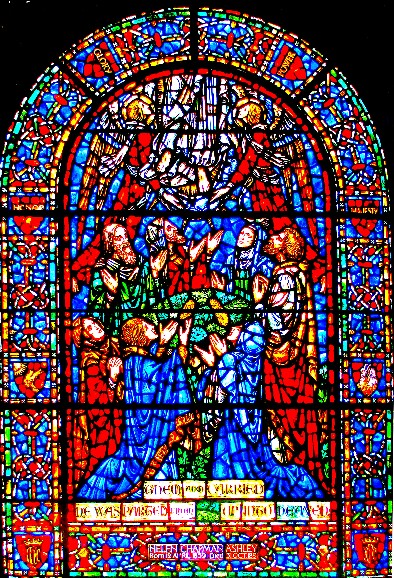 As
I stepped on the scales on my 75th birthday, I was delighted to have reached
my goal of weighing less than 130 pounds. This is down from a pudgy 154
a year or so ago. The day was off to a good start. (The new goal is 125.
I still want to fit into pants I found decades ago.) And I did my 30-minute
brisk walk in 28 minutes. As
I stepped on the scales on my 75th birthday, I was delighted to have reached
my goal of weighing less than 130 pounds. This is down from a pudgy 154
a year or so ago. The day was off to a good start. (The new goal is 125.
I still want to fit into pants I found decades ago.) And I did my 30-minute
brisk walk in 28 minutes.
May 25 is also the birthday of Ralph Waldo Emerson. He would be 214 years old. Emerson lasted three years as a Unitarian parish minister; I served fifteen, for which I am grateful; thereafter my career status as a Unitarian Universalist minister changed from “parish” to “community” minister, and now “retired.” Like Emerson, I have read beyond Christian literature, with most of my work devoted to interfaith activities. I would have argued with him about lots of things, including communion, which he felt he could no longer administer with integrity. His doubts about Christian beliefs were modern of the sort perverted by the Enlightenment. A Transcendentalist and a Romantic, his individualistic themes have helped to bring us less the development of character and more the Gospel of Greed and Ayn Rand and now Donald Trump. If Emerson had understood the Eucharist better as the loving and just sharing of divine grace, maybe the benefits of his influence would have been less likely to have been ccorrupted. May his birthday encourage me to be ever self-critical and benefit from learning from others. My own sins should make me more understanding of others; and even if God may have forgiven me, I need to be mindful of past and potential wickedness lest I become untethered from the earthly realm in which the joy of duty best fulfills. Speaking of the Eucharist: my day’s highlight was
attending Mass at the church where I am a member, Grace and Holy Trinity
Cathedral (Episcopal). The liturgical calendar this year gave my birthday
the extra blessing of the Feast of the Ascension.(See
Acts 1:9, Mark 16:19--an appendix not in the oldest manuscripts, Hebrews
4:14, and an interpretation of Psalm 110 and Daniel 7:13; Luke 24:51-52
is doubtful; clearly the story is a later tradition influenced by cultural
patterns, and the feast developed even later.) The sixth of the
Cathedral chancel windows depicts this final episode in the story of the
earthly life of Jesus. I love the entire set. Christ, at last untethered
to the earthly realm, is that freedom in the mystics’ raptus beyond distinctions,
or, to use a Buddhist phrase, “entering the gate of the not-two doctrine,”
an ecstasy to be enjoyed but not possessed; as the disciples could not
cling to Jesus, the mystic may be changed by the experience, but must not
cling to it. One must let it go.
Ascensions, assumptions, and other risings (sometimes with apotheosis) into heaven are common in Judaism, Egyptian, Greek, and Roman ancient religions and of course the Hellenistic culture (my favorite is, of course, Ganymede, but Hercules also deserves mention), alchemy, shamanism, Zoroastrianism, Islam, Mesoamerican traditions, Daoism, and other faiths. Two thousand years from the Christian story’s setting, we know you can’t find God above the clouds anymore than you can find him below; that above 30,000 feet, oxygen is pretty thin and you’ll shiver and die; that we have airplanes and spacecraft of various sorts to leave the ground; and the message of the Christian story may be less an astronomical tale than a paradigm image of the exaltation of the Savior as divine, the mystical union with God, and for us below to do the healing work of love He has given us to do here right on earth.
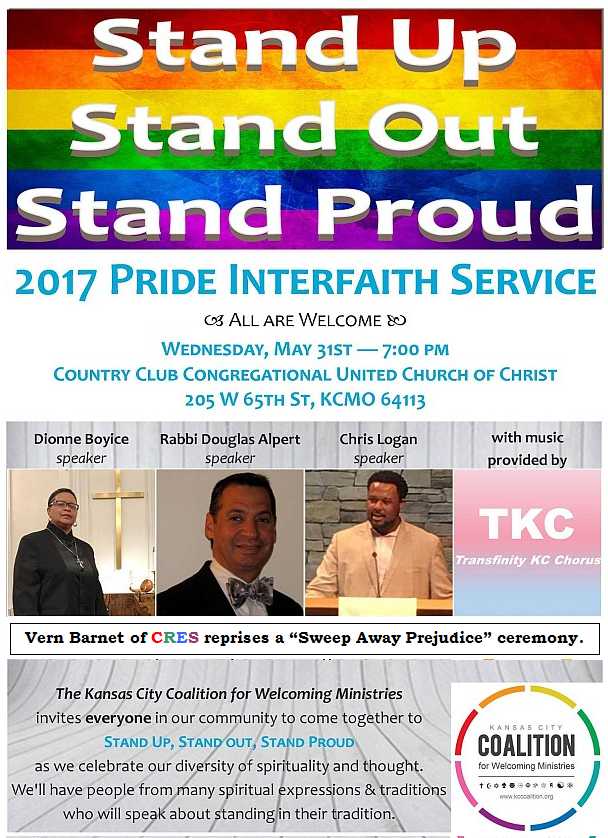
Unannounced, Vern began the sweeping ceremony from
the front entrance of the church, sweeping up the central aisle, from the
back to the front of the pews, using the words below.
[sweep]
[sweep]
[sweep]
#170920Bias Healing Religious Bias
Our community and the world can be healed from its religious prejudice and fragmentation by learning how to talk with others about their faith perspectives. This session includes information, theory, and practice. Learning Community Session Objectives:
Advance Reading
Dialogue Institute of Southwest-Kansas City 4215 Shawnee Drive -- Kansas City, KS 66106 2017 October 28 Saturday brunch 10:30 am Has Science Eclipsed Religion?
Dr Vern Barnet outlined (1) the interplay between science and religion since the Renaissance leading to the desacralization of the world. (2) He then asked how to recover the sense of the sacred — in nature, personhood, and society, with Primal, Asian, and Monotheistic faiths to restore us with nature, heal the self, and find community in covenant. The lecture concluded with a story from the Khassidischen Bücher of Martin Buber via Heinrich Zimmer via Vern's teacher, Mircea Eliade. These notes cover the first part of the lecture. For a short time 2017 Aug 21, the moon eclipsed the sun, but while the sun disappeared from sight, its gravity persisted. Since the Reformation, science has come to eclipse spirituality (breathing with a sense of the sacred) and religion (folks living with a sacred focus), but religion’s power remains, obscured by secularism. The sacred is the non-dual reality on which our lives depend. We usually do not see it since we are embedded within it, as we often do not notice the air we breathe around us. Science as a separate activity is similarly embedded in our broken and fragmented world. But from a religious, holistic, sacred perspective, science is an unacknowledged religious activity, and accountable to religion. Here I cannot show how technological evils (such as the bomb and environmental threats) arise because science has been spilt off from faith, but I do outline how we got to this peril. Beginning with Plato, and developing with 1620 Francis Bacon’s natura vexata and 1637 Descartes’ dualism and mathematical paradigms, nature was severed from faith, nature objectified in categories, controlled, and used. Consider the changes from reading aloud, to adding spaces between words in written texts, to reading silently, to movable type, to the spread of literacy, to the Reformation’s focus on the word over sacred images (in extreme cases, actual hostility to such images), to the categories and quantifications of the Enlightenment and its Modernist development. Anthropologist Edward Burnett Tylor (1832-1917) has been particularly harmful for his "scientific" focus on religion as explanation, and Sigmund Freud (1856-1939) offered a particularly influential reduction of religion to mere psychological processes. Religion — arising from wonder and mystery, expressed
in thanksgiving, and matured in service — has been seduced by scientism
to ignore the sacred, and faith is now often also conceived in terms of
facticity, categories, partialisms, and literalism, even fundamentalism.
The change in meaning of the word “believe” illustrates this: the word
now often means accepting a statement or proposition such as “I believe
the earth is round.” But originally it meant commitment, affection for,
loyalty to, participation with, as in “I believe in my spouse.” The word
is related to the German, liebe, love; even into the early 17th
Century, “believe” meant more like “belove.”
Religion degenerates with the development of language. It is redeemed only when language points, rather than describes. (Consider Vico.) In Christianity (the dominant Western faith), the paramount example of this desacralization is the Zwinglian doctrine of Communion as simply a memorial. Placing Communion in the category of sign rather than the experienced mysterious sacrifice of Christ — with the change of the bread and wine into His very body and blood — was a momentous advance in the tyranny of scientific literalism as reality. Even Cranmer, who defended the practice of reception of the elements by kneeling, did, perhaps forced to do so, add the “black rubric” to the second Book of Common Prayer and changed “altar” to “table.” Indeed, the utter extremity, and almost laughable literalism of the “black rubric” is in its conclusion: “For it is agaynst the trueth of Christes true natural bodye, to be in moe places then in one, at one tyme.” While it can be argued that implicit in the medieval distinction between the accidental and substantial natures of the bread and wine is the seed of literalism, it took the rise of printing, Protestantism, and scientism to complete the degeneration of language about the Eucharist. Gregory Bateson contrasts Catholic with Protestant views of Communion as the difference between metaphor (“Watch out for him, my friend; he is a fox”; “This is the body of Christ”) and simile (“Watch out for him, my friend; he is like a fox”; “This is like the body of Christ”). The metaphor is a mythic or poetic equation— While they were eating, Jesus took bread, and when he had given thanks, he broke it and gave it to his disciples, saying, Take and eat; this is my body.” This is metaphor, myth; but a simile is a literal comparison. The literalism of the extreme Reformers ignores the performatory nature of language and the ecclesial, contextual meanings of “the Body of Christ,” some of which Hooker may have sensed in his latitude, moderating some Enlightenment-like discrete categories. Fortunately the Anglican tradition of “real presence” can elevate the experience of the communicant above the categories of thought which can divert the Christian from the enjoyment of, and transformation by, the Mystery. One is welcomed with any theological understanding of the Eucharist, or none; the experience, not the theory, counts. The Reformers who scoffed at the Catholic teaching
of transubstantiation as superstition were deeply corrupted by the incipient
literalism in the air, as are those today who find Hindus worshipping idols
to be silly and stupid, rather than advanced intellectually and spiritually.
If you think that material objects are mere signs or empty symbols, or
vague memorials, consider those who are willing to die for a piece of cloth
called the flag.
Alas, the desacralization, the literalization of Christianity has infected other faiths through Western imperialism. Islam is a particularly painful example, for even this extraordinarily beautiful faith has been corrupted by Western hegemony, and in rare cases reflects the iniquity of our own violence. Here are some contrasts to consider:
Alexander Pope’s brilliant epitaph for Isaac Newton
placed Newton’s signal achievements in exploring the nature of light and
other physical phenomena, in the context of the first chapter of the Bible
stories of creation. But what a perceptive contrast! is William Blake’s
rejoinder emphasizing the participatory nature of perception, anticipating
certain quantum mechanical interpretations of our time.
Annual Interfaith Thanksgiving
Dinner
Although this event is no longer sponsored by CRES, we list it since its "Vern Barnet Interfaith Service Award" is named for the CRES minister emeritus, who founded the Interfaith Council in 1989. The text below is by the ADL and the Council. Since 2010, this beloved annual event has been sponsored by the Heartland Chapter – Alliance of Divine Love and the Greater Kansas City Interfaith Council, in cooperation with the interfaith community. Heartland Chapter – Alliance of Divine Love announces that the 2017 Vern Barnet Interfaith Service Award, named in recognition of the lasting contribution of Rev. Vern Barnet to our vibrant interfaith community, will be presented to Sheila Sonnenschein, past Chair of the Greater Kansas City Interfaith Council and a long-time director of the Council, as well as co-chair of the annual Table of Faiths in 2006 and 2007.
Sheila was the first non-Muslim board member of the Crescent Peace Society, a former board member of the National Council of Jewish Women and a former board member of the Kansas City Press Club. Her articles have been published in The Catholic Reporter, Outlook Magazine, The New Light, Being Jewish, Suburban Journal of St. Louis, The Kansas City Star, and, the Kansas City Jewish Chronicle. The 2017 Annual Interfaith Thanksgiving Dinner will be hosted at the new Islamic Center of Johnson County, located at 9005 West 151st Street, Overland Park, KS 66221. The Islamic Center of Johnson County serves the spiritual, religious and communal needs of Muslims in the cities of Overland Park, Leawood and Olathe through this new, permanent center and also serves the larger Kansas City Metro community through outreach, charity work and civic engagement. Heartland ADL is also pleased to announce that the 2017 dinner marks the beginning of a partnership with Episcopal Community Services, 501c3 nonprofit, as caterer for the dinner. Episcopal Community Services has been serving the Greater Kansas City area since 1989 and operates the Kansas City Community Kitchen, a novel approach which blends various food-related programs, including training for culinary careers, food pantries, and community garden projects. ECS is nationally known for restaurant-style food service, which provides dignity, as well as food. In recognition of this new partnership, Episcopal Community Services has been selected as the recipient of donations from this year’s dinner.
The Rev David
E Nelson, DMin, president of The Human Agenda and senior associate minister
with CRES, and Vern Barnet congratulate award recipient Sheila Sonnenschein.
A portion of the Heartland
ADL report. Click for the full report.
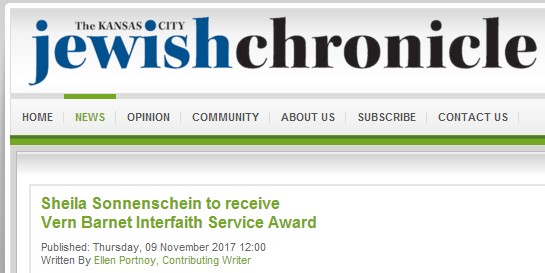

For the past 12 years, Shelia Sonnenschein has been a beacon of light in the Kansas City interfaith community. She has volunteered diligently to build relationships among people of different faiths, especially Jewish and Muslim women. Her volunteer work is recognized by many in the interfaith community. On Nov. 12, they will recognize it publicly when Sonnenschein will be presented the Vern Barnet Interfaith Service Award at the annual Interfaith Thanksgiving Dinner. Sonnenschein’s involvement in the interfaith community began by happenstance. She took a writing class in January of 2002, after she and her husband, Ken, returned to the Kansas City community. “In that class I met an American Muslim woman, Mahnaz Shabbir,” Sonnenschein said. “I saw that we had a lot in common. We each had four kids; our husbands were psychiatrists; and we both knew what it felt like to be targeted because of our religions. We met people from our respective communities. That’s what started my multi-faith journey in Kansas City.” The journey has taken Sonnenschein all over the world. But first it led to her involvement in the Greater Kansas City Interfaith Council. Shabbir took Sonnenschein to her first meeting in 2005, as an alternate. “Soon after, I became a Council director,” she said. “I have been on the board ever since.” She has served as a director of Kansas City for Refugees and the Kansas City Interfaith Youth Alliance. She helped found the Table to Table program for Yachad, the Kosher food pantry. As a member of the interfaith community she was involved in the Festival of Faiths committee; started the Facebook online initiative Mothers on the Side of Peace. She also helped to start chapters of the Sisterhood of Salaam/Shalom in the Kansas City area. She is the first non-Muslim board member of the Crescent Peace Society and is a former board member of National Council of Jewish Women, Greater Kansas City Section, where she helped with their interfaith luncheon. Among the friends she has made during her interfaith activities is Inas Younis, who was born in Iraq but now lives in Overland Park. Younis, who was the Muslim woman behind bringing Sisterhood of Salaam/Shalom to Kansas City, says this about Sonnenschein: Sheila is “is a social engineer with an intuitive capacity to bring people together who would have otherwise never crossed paths. Never cynical, always earnest, Sheila practices what most of us only preach. She takes conscious steps to ensure that everyone feels included and valued. She is a credit to our interfaith community and I am proud to have her as a friend.” The Sisterhood of Salaam/Shalom (SOSS) takes up much of Sonnenschein’s time now. She has helped with the formation of two more sections. Three are now active in the Kansas City area. She also has been to the SOSS annual convention at Drew University in Madision, New Jersey, where women of both faiths come together to share and learn. This year the meeting was held Nov. 3-5. She has traveled to Albania to meet with interfaith communities. And she has brought the information she learned back to Kansas City. Two years ago, she was part of a group who arranged for the movie, “Besa,” (Faith) to be shown in Kansas City. This movie is about an Albanian Muslim family who safeguards religious books of a Jewish family during the Holocaust. The besa, promise or faith, is to one day return the books to the family. “I think it’s important to listen to each other,” Sonnenschein said. “I encourage adults and youth to attend programs that promote getting to know people of other religions and cultures. … Interfaith Youth Core (IYC) founder Eboo Patel says that if we catch people when they are young so they don’t fall into the hands of extremists, we can do a lot of good for our world.” The Heartland Chapter — Alliance of Divine Love (ADL) and the Greater Kansas City Interfaith Council are sponsoring the dinner. The Heartland Chapter-ADL “is part of an international interfaith ministry, which recognizes and honors the validity and wisdom of all faith traditions,” according to its website. The event will be held on Sunday, Nov. 12, at the new Islamic Center of Johnson County in Overland Park. The organization preparing the meal is NourishKC, which is a nonprofit that provides restaurant-style food services in community kitchens. All donations from this year’s dinner will benefit NourishKC. Cost is $15 for adults and $10 for students. Tickets can be purchased at http://interfiaththanksgiving2017.brownpapertickets.com.
You are welcome even if you
have not read the book or seen the movie
“The purpose of a Vital Conversation is not to
win an argument,
that will add value to the participants and to the world. In Vital Conversations, we become co-creators of a better community. --David Nelson The discussions began May 24, 2002, at the CRES facility by examining Karen Armstrong's The Battle for God
#2017VitalSchedule 2017 Vital Conversations Schedule 2017 January 11
 February
8 February
8
Seldom Seen: A Journey into The Great Plains by Patrick Dobson. In May 1995, with nothing but a backpack and a vague sense of disquiet, the author left his home and a steady deadening job in Kansas City. Over the next two and a half months he made his way to Helena, Montana. He not only meets a series of very interesting people and makes a difference in their lives, but introduces the reader to a clearer understanding about the meaning of relationships and life. Canoeing the Great Plains: A Missouri River Summer is part two of this adventure in our wonderful part of the country. This time Patrick travels down the Missouri river and communes with nature and people. As the miles float by and the distinctions blur between himself and what he formerly called nature, Dobson comes to grips with his past, his fears, and his life beyond the river. Patrick Dobson joined us for this fascinating conversation. 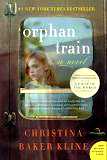 March
8 March
8
Orphan Train by Christina Baker Kline. Between 1854 and 1929, so-called orphan trains ran regularly from the cities of the East Coast to the farmlands of the Midwest, carrying thousands of abandoned children whose fates would be determined by pure luck. The National Orphan Train Complex is located in Concordia, Kansas. Several of you have visited this complex and others could visit it soon. This book follows the story of several specific children. You can explore and bring additional stories to the conversation. For NPR's broadcast, go to http://www.tinyurl.com/hfs4ezn. April 12
May 10
June 14
August 9
September 13
#171011 2017 October 11 
Islam and The Future of Tolerance, A Dialogue Sam Harris and Maajid Nawaz (respectively, author of The End of Faith and author of Radical). We have read and discussed both these authors in the past. In this short book, you are invited to join an urgently needed conversation: Is Islam a religion of peace or war? Is it amenable to reform? What do words like Islamism, jihadism, and fundamentalism mean in today’s world? Ahmed El-Sherif, prominent Muslim and interfaith leader, joins us for the discussion, shown here offering the Adhan at the Rime Buddhist Center. A bio sketch appears at www.cres.org/pubs/ahmed.htm. Ahmed will Skype an authority on Islam in Mecca, Dr. Abdullah Alleheedan.
November 8 One Hope: Re-Membering the Body of Christ. 2017 marks the 500th anniversary of the beginning of the Reformation. The split between Roman Catholics and Lutherans played a major role in that series of events that changed the Church. This is a resource for those interested in exploring greater cooperation between part of “The Body of Christ.” The essays in One Hope are the product of an intense collaborative process by six gifted scholars and pastoral leaders, three Lutheran and three Catholic. December 12
Selections are subject
to change. If you would like to be reminded and have additional information,
contact David Nelson at humanagenda@gmail.com or call (816) 453-3835
ABOUT CRES PARTICIPATION Having spawned several other organizations, including the Greater Kansas City Interfaith Council, we continue to offer programs initiated by and through others but we no longer create our own in order to focus on our unique work. For interfaith and cultural calendars maintained by other groups, click here.
|
|||||||||||||||||||||||||||||